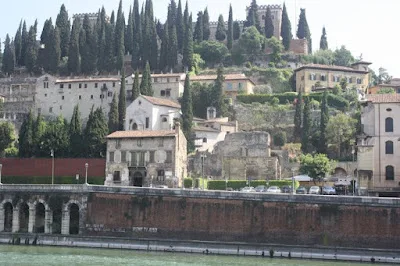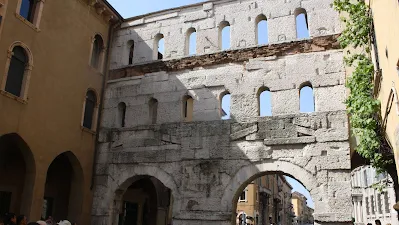Verona
in summer has cool breezes and gentle streets, in a city of romance and love in
Italy. The simple vibes add to the sense of love in the air. Rustic stone
landmarks in Verona add more feeling to the city. Verona is in northern Italy,
in the Veneto region between Milan and Venice.
Driving to Verona from Venice (TOP SITES IN VENICE) takes about two hours, and an overnight stay makes the experience more meaningful. Listed as a UNESCO World Heritage Site, Verona has existed for over 2,000 years. Its heritage sites make the city one of the top attractions in Verona. Walking through the city unhurriedly while stopping at sightseeing spots, with breaks for lunch or coffee, fits the pace of Verona.
The main things to do in Verona Italy include sightseeing at the historic landmarks, highlighting Verona attractions throughout the city (ROME ITALY BEST PLACES TO SEE).
One of the most natural attractions in Verona is the Adige River. Walking along the paths on its riverbanks is a scenic experience that begins in Verona itself. The Adige is the second-longest river in Italy and has shaped the city for over two thousand years. It divides Verona into two parts, with several historic bridges connecting neighborhoods along its banks.
Historically, the river was important for trade and transport, helping Verona become a key city in northern Italy. The Adige also played a role in defending the city, with fortified walls built along its edges. Today, the river hosts boat events, seasonal markets, and festivals. Not far from Lake Garda, the river provides beautiful views from Via Ponte Pietra, with sights of both riverbanks and the surrounding hills.
The Adige River is an essential part of Verona sightseeing, adding to the top things to do in Verona and highlighting one of the city’s main Verona attractions.

Saint Anastasia Church
Within a walking distance of about 10 minutes from the Adige River is Saint Anastasia Church, the largest church in Verona. Standing in front of it and taking a glimpse inside, the surroundings and upper views add significance as part of Verona sightseeing. The spirituality can be felt instantly. Built between the 13th and 15th centuries, Saint Anastasia Church is a key example of Gothic architecture in Italy.
The church features a tall brick façade, high arched ceilings, and several detailed wall paintings. A highlight is the Pellegrini Chapel, which houses a wall painting by Pisanello, a well-known artist from the 15th century. Near the entrance, there are also holy water fonts supported by carved figures known as the “hunchbacks of Verona.”
Informational pamphlets are available at the entrance, and entry into the church is permitted. However, it is best to check the opening hours, as entry may not be allowed during weddings or religious ceremonies. Even so, admiring the church from the outside or up close remains worthwhile.

Scaliger Tombs
The Scaliger
Tombs in Verona stand as striking reminders of the city’s medieval past.
Located near Piazza dei Signori, the tombs are easily noticeable from the main
road, surrounded by decorative iron fences. These monumental graves belong to
the powerful Scaliger family, who ruled Verona during the 13th and 14th
centuries.
Built in Gothic
architectural style, the tombs rise above ground with pointed arches, spires,
and finely detailed carvings. Each structure reflects the prestige and
influence of the Scaliger dynasty that shaped Verona’s history. Within the
small enclosed area, there’s a staircase and a covered structure resembling a
well, adding to the distinct medieval character of the site.
The most
renowned among them is the tomb of Cangrande I della Scala, a distinguished
ruler known for his leadership and as a patron of Dante Alighieri. The Scaliger
Tombs remain one of the most significant historical landmarks in Verona,
admired for their artistry, craftsmanship, and deep connection to the city’s
heritage.

Casa di Romeo (Romeo’s House)
Verona brings
literature to life as the setting of William Shakespeare’s “Romeo and Juliet.” Although Shakespeare never visited Italy, he chose Verona as the backdrop for
the tragic love story, likely inspired by earlier Italian tales. This is why
the city is often called the “City of Love” and the “City of Romeo and Juliet.”
Casa di Romeo,
or Romeo’s House, is located on Via Arche Scaligere, along the same route as
the Scaliger Tombs. The house once belonged to the Montecchi family, believed
to have inspired the Montagues in Shakespeare’s play. Viewing the interior is
not allowed, and entry is restricted, but standing across from it gives a sense
of connection to Verona’s literary past.

Juliet’s House (Casa di Giulietta)
Less than ten
minutes away is Juliet’s House, known for its famous balcony. The entrance
feels like walking into a small castle with an old stone archway. It is one of
the best-preserved historic buildings in Verona and a key landmark linked to Shakespeare’s
“Romeo and Juliet.”
The house
blends Romanesque, Gothic, and Renaissance architectural styles. At the
courtyard, the bronze statue of Juliet draws the most attention. Many wait to
take photos with it. Legend has it that touching the right breast brings luck
in love, a belief that continues to this day.
Across from the
statue stands the well-known balcony, where it’s a popular spot for taking photos, from below or step onto it for a closer view. Inside, the museum
showcases 14th- and 15th-century artworks, such as images of Madonna and Child,
“The Last Kiss” by Francesco Hayez, and costumes from Franco Zeffirelli’s 1968
film.

Mazzanti Houses
The Mazzanti
Houses date back to the 14th century. They were first used as a grain warehouse
by the Scaligeri family, who ruled Verona at that time. In 1527, the Mazzanti
family took ownership and hired Alberto Cavalli to paint the façades with
mythological and symbolic scenes.
These colorful
wall paintings gave Verona the nickname Urbs Picta, meaning “painted city.”
Though entry is not allowed, the Mazzanti Houses remain one of the
best-preserved painted buildings in Verona.

Piazza delle Erbe
Piazza delle
Erbe is one of Verona’s oldest and most vibrant squares. It features the Lamberti
Tower, beautifully frescoed buildings, and the nearby Mazzanti Houses. At the
center stands the Madonna Verona Fountain, built in the 14th century and topped
with a Roman-era statue holding a scroll that represents Verona’s ancient
heritage.
The square is
among the most photographed spots in the city, where many stop to look around
and admire the surrounding architecture.
Porta Borsari
Porta Borsari
is an ancient Roman gate from the 1st century AD. It once served as Verona’s
main southern entrance. Located along Corso Porta Borsari, the gate has two
large arches and an upper level with windows.
Although the
interior is closed to the public, the structure’s stonework and carvings are
well-preserved. It is one of Verona’s best Roman landmarks and easy to see
while walking through the historic center.









